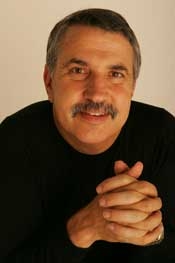Thomas Friedman calls for 'green revolution'
A "green revolution" driven by innovative energy technologies, such as the National Ignition Facility, is what is needed to revitalize the economy and for the United States to once again find its inventive "groove."
That’s what New York Times columnist Thomas Friedman told Laboratory employees in a Director’s Distinguished Lecture Series address entitled, "Hot, Flat, and Crowded: Why We Need a Green Revolution And How It Can Renew America," which also is the title of his latest book.
Furthermore, Friedman said the daunting global environmental and energy challenges of today are "a list of incredible opportunities masquerading as insoluble problems." He divided these challenges into five "global megatrends": Energy and natural resources supply and demand; climate change; petro-dictatorships; energy poverty; and biodiversity loss.
"What’s cool about this list is that all problems have the same solution: abundant, cheap, clean and reliable energy technology," Friedman said. "How cool is that? And that’s what you’re working on right here in Livermore.
"The country that owns energy technology will have security and global respect," he said. "That country has to be the United States of America. There’s nothing bigger than energy technology."
Getting America’s groove back
"We’ve lost our groove in this country," he said in his introductory remarks. "We need to get our groove back by taking on the biggest challenges."
He said he was motivated to write the book because of a widespread perception that the United States had lost its ability to innovate — a perception driven home by a billboard for a "smart car" car he saw in South Africa, touting "German engineering, Swiss innovation" and ensuring there was "nothing American."
"It was wrong. American innovation is second to none," Friedman said. "That (perception) runs contrary to my experience traveling around the country. Rock stars collect room keys and I get business cards from energy innovators. It’s terribly exciting. I hear the craziest stuff. It’s a sign to me that American innovation is alive and well. The country is actually exploding with innovation and entrepreneurship from the ground up. It gives me hope that we can and will get our groove back."
Friedman said a part of the problem is that the government in Washington has failed to maximize the country’s innovative prowess "at the speed, scope and scale that we need."
He likened the state of innovation in the nation today to a picture of the space shuttle taking off. "All this incredible thrust coming from below; that is all the innovative prowess and energy that’s percolating from below in America," Friedman said. "But in our case, the booster rocket in Washington D.C. has been cracked and weak in energy, and the pilots in the cockpit have been fighting over the flight plan. As a result, we as a society have not been able to reach the escape velocity we need to get into the next orbit, the next great industrial revolution, which I believe is something called ‘ET’ — energy technology."
Hot, flat and crowded
Explaining the title to his book, Friedman said "hot" refers to global climate change, and "flat" is a metaphor for "the rise of middle classes all over the world, a flatter world, who can now compete and collaborate like and with Americans."
"It’s a blessing that so many people around the world can live like us, can now drive American-size cars, drive on American-size highways and live in American-size homes and eat American-size Big Macs," he said. "There’s just one problem with this many Americans and when this many people can live like us, unless we, the original Americans redefine what it means to be an American in more sustainable terms, and invent the tools, as many of you are involved in doing now, that will allow more people to live like Americans. If we don’t do that we are going to burn up, choke up, heat up and smoke up this planet."
"Crowded" refers to dramatic population growth. Friedman illustrated his point with a slide showing that the world population in 1830 was 1 billion people and in 2008 there were 1 billion teenagers. "We’re adding another billion people every 13 years," he said. "The world is getting hot, flat and crowded."
The simple thesis of his book is that "hot, flat and crowded were three flames that came together around the millennium, the year 2000, which I call year one of the new era we’re in, the energy-climate era — 1 EC. They all came together to create a huge fire," Friedman said, explaining this fire is what is driving the five global megatrends referenced above (Energy and natural resources supply and demand; climate change; petro-dictatorships; energy poverty; and biodiversity loss).
"These five trends and how we rise or do not rise to these challenges will really determine the stability or instability of our planet in the early 21st century," he said.






